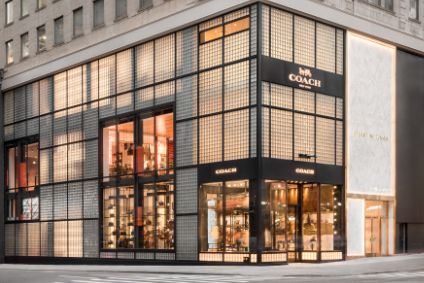
Tapestry, Inc, a New York-based house of accessories and lifestyle brands including Coach, Kate Spade, and Stuart Weitzman, has reported results for the fiscal third quarter ended 2 April:
- Q3 net sales totalled US$1.44bn compared to $1.27bn in the prior year, representing a 13% increase.
- Sales at Coach, Kate Spade, and Stuart Weitzman were up by 11%, 19%, and 11% respectively.
- Digital revenue up 20% on the same quarter last year.
- Net income for the quarter was $123m on a reported basis, compared to $92m in the prior-year period.
- Gross margin narrowed to 69.9% from 71.6%. As anticipated, gross margin was negatively impacted by incremental freight expense in order to maintain product flow to meet consumer demand, which totalled $63m or 440 basis points.
- For fiscal year 2022, Tapestry expects revenue of about $6.7bn, which represents a high-teens growth rate versus the prior year on a 52-week, comparable basis, and would mark a record level of sales for the company.
“Our third-quarter results significantly exceeded expectations led by continued strong growth in North America. We drove increased customer demand at Coach, Kate Spade, and Stuart Weitzman, reflecting the vibrancy of each of our brands, the power of our platform and our team’s successful execution of our strategic initiatives,” says Joanne Crevoiserat, CEO of Tapestry, Inc.
“Our performance reinforces the meaningful runway ahead across our portfolio. We are harnessing our unique blend of magic and logic – distinctive brands amplified by an agile and data-rich platform. These differentiators enable us to deliver the continuous innovation necessary to build lasting customer relationships in the context of a rapidly evolving landscape. We remain confident in our long-term growth opportunities and steadfast in our commitment to enhance value for our customers and shareholders.”
Commenting on the numbers, Neil Saunders, managing director of GlobalData, notes Tapestry was up against a tough prior year comparative from 2021 when sales grew by 18.7%.
“However, the company more than rose to the challenge, posting a 12.9% increase in overall revenue. This means that, on a two-year basis, revenues have grown by an impressive 34%; on a three-year basis, which compares with the pre-pandemic 2019, revenues have risen by 8%. On this basis, both Tapestry’s momentum and its skill in navigating the pandemic is very clear.”
Saunders adds geographically, the results have been driven by North America where revenue is up by 22% over the prior year. Comparatively, sales in China declined by mid-teens due to the reemergence of Covid and various lockdowns and restrictions.

US Tariffs are shifting - will you react or anticipate?
Don’t let policy changes catch you off guard. Stay proactive with real-time data and expert analysis.
By GlobalData“As such, there should be some future momentum from China as and when the current crisis starts to abate,” he adds. “In our view, this will be helpful as we move into the quarters ahead. North American growth has been delivered against a mixed economic backdrop that has been a little more challenging than previous quarters. Rising inflation has been eroding disposable income and consumer confidence has become choppier. Admittedly, the full force of these problems did not hit until late in the quarter; however, there is cause for optimism that Tapestry is weathering the storm well. While core customers at all Tapestry brands are affected by inflation their income and financial profile means they can cope with its impacts much better than the average consumer. As such, there are few signs that they are – at least, as of yet – moderating their consumption habits, especially on treats and luxuries for themselves.
“Another factor in Tapestry’s favour is that a large chunk of growth is driven by customer acquisition, with the company estimating it has added 1.4m shoppers in the past year. Much of this is down to better use of social media and digital channels, with data being used to understand how to target messages to particular groups of consumers. We estimate that around half of new customers are under 40 and that a fair slice come from Gen Z. Overall, this dynamic is a helpful hedge against inflation both because younger shoppers are generally less impacted by heavy price increases, and because any future cutting back of volumes by core customers can be offset by new customer spending.
“Coach’s revenue increased 11.3% and is up an impressive 11% over Q3 of 2019. In our view the product mix at Coach is strong, with a good balance of iconic designs and new styles helping to drive conversion. There has also been a notable pull-back on promotion and discounting, likely because of better inventory planning and a stronger assortment. Men’s products remain a smaller part of the sales mix, but ranges have been improved and they are now making a more meaningful contribution to growth.
“At Kate Spade revenue rose by a robust 19.5% and is up 7% compared to 2019. Here we are pleased by the transformation of Kate Spade and believe that the brand is now back on track after several years of reinvention. Styling is now more distinct, and customers are presented with a more cohesive selection of products across apparel and accessories. This is helping to reactivate previous shoppers who had fallen out love with the brand as well as attracting new customers.
“Stuart Weitzman remains the laggard and, while sales rose by 10.8%, they are down by 25% compared to 2019. The rebuilding activity is in place here, especially via wholesale channels, but there is more work to do to get the brand back on track. Fortunately, Tapestry has breathing space to execute this as its other brands are delivering solidly.”
Tapestry recently partnered with World Wildlife Fund (WWF), through a US$3m philanthropic grant from its Tapestry Foundation to develop an innovative system to enhance traceability of the leather value chain in Brazil.


